Summer Sunset |
||||||||||||||||||||||||||||||||||||||||
 |
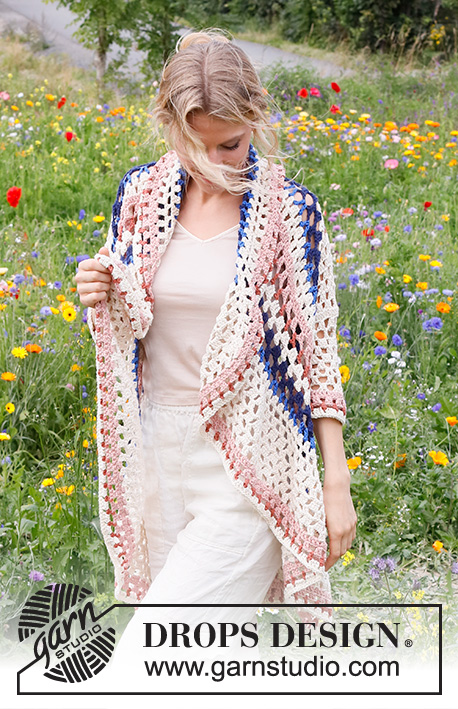 |
|||||||||||||||||||||||||||||||||||||||
Crocheted circle jacket in DROPS Paris. Piece is crocheted with stripes and lace pattern. Size: S - XXXL
DROPS 230-33 |
||||||||||||||||||||||||||||||||||||||||
|
---------------------------------------------------------- EXPLANATION FOR THE PATTERN: ---------------------------------------------------------- CHAIN STITCH: If you work at the end of crochet hook the chain stitch will often be too tight. 1 chain stitch should be just as long as 1 double crochet/half treble crochet/treble crochet is wide. PATTERN: See diagrams A.1 to A.7. STRIPES: ROUNDS 1-2: Work with colour desert rose. ROUND 3: Work with colour rust. ROUNDS 4-5: Work with desert rose. ROUNDS 6-7: Work with colour navy blue. ROUND 8: Work with royal blue. ROUNDS 9-10: Work with off white. ROUNDS 11-20: Work as 1st-10th round. ROUNDS 21-30: Work as 1st-10th round. DECREASE TIP (evenly): To calculate how to decrease evenly, use the total number of stitches on row (e.g. 336 treble crochets), and divide stitches by number of decreases to be done (e.g. 12) = 28. In this example decrease by working every 27th and 28th treble crochet into 1 treble crochet. Decrease 1 treble crochet as follows: * Work 1 treble crochet but wait with last yarn over and pull through, work 1 more treble crochet but on last pull through, pull yarn through all loops on hook.(= 1 treble crochet decreased). ---------------------------------------------------------- START THE PIECE HERE: ---------------------------------------------------------- CIRCLE JACKET – SHORT OVERVIEW OF THE PIECE: Piece is worked in the round from the middle of circle (= mid back). When circle is done, work right and left side piece. Work side pieces back and forth. Then work an edge around the entire circle and side pieces. Then work the sleeves in the round, top down. CIRCLE: Work 5 chain stitches – read CROCHET TIP FOR CHAIN STITCH, on hook size 5.5 mm with colour desert rose in DROPS Paris, and form a ring with 1 slip stitch in 5th chain stitch. Then work STRIPES – read explanation above, and pattern as follows: Work A.1 (shows how round begins and ends), work A.2 8 times in total on round. REMEMBER THE CROCHET TENSION! When A.1 and A.2 have been worked vertically, there are 56 chain spaces on round (= 224 stitches) and piece measures approx. 42 cm in diameter. Now work arm holes as follows: Work 1 slip stitch around next chain space, then work A.3a (shows how round begins and ends), work A.3b around the first 7-8-8 chain spaces, work 28-32-36 loose chain stitches and skip the next 7-8-9 chain spaces for armhole, work A.3b until 14-15-17 chain spaces remain on round, work 28-32-36 loose chain stitches and skip the next 7-8-9 chain spaces for armhole, work A.3b over the last 7-7-8 chain spaces. Continue in the round with A.3a and A.3b, but over the 28-32-36 loose chain stitches work 7-8-9 repetitions with A.3b. On last round decrease at the same time on 12 treble crochets evenly - read DECREASE TIP = 324 treble crochets. Now work as follows: Work A.4a (shows how round begins and ends), A.4b the entire round. When A.4a and A.4b are done, there are 162 chain spaces on round. Piece measures approx. 100 cm in diameter. Size S/M is now done - work as explained below. Continue as explained in size L/XL and XXL/XXXL if you want the piece to be longer (an edge of approx. 8 cm remain mid back). Cut the yarn. In size L/XL and XXL/XXXL work as follows: SIZE L/XL AND XXL/XXXL: Continue with colour off white. Work A.5b on round – every round begins with 3 chain stitches and ends with 1 slip stitch in 3rd chain stitch at the beginning of round (= replaces first treble crochet on first round and last treble crochet on last round). Work the last 2 rounds in diagram 1-2 times vertically in total. Piece measures approx. 106-113 cm in diameter. Cut the yarn. ALL SIZES: Now only work over 49 chain spaces in each side. Insert 4 marker threads in piece as follows without working: Skip the first 16-17-17 chain spaces (= up towards the neck), insert a marker thread in next chain space, skip the next 47 chain spaces, insert a marker thread in next chain space (= left side), skip the next 32-31-30 chain spaces (= down on body), insert a marker thread in next chain space, skip the next 47 chain spaces, insert a marker thread in next chain space (= right side), 16-16-17 chain spaces remain on round after last marker thread (= up towards the neck). LEFT SIDE: = 49 chain spaces. Work the entire left side in colour off white and work back and forth. Begin from right side in chain space with marker thread, fasten strand with 1 slip stitch in first chain stitch in chain space and work as follows: Work A.5a over the first 2 chain spaces, A.5b over the next 45 chain spaces, A.5c over the last 2 chain spaces. Continue back and forth like this. When diagrams have been worked vertically, repeat the last 2 rows vertically 2 more times (= 6 rows in total vertically). Cut and fasten the yarn. RIGHT SIDE: Work the same way as on left side - begin from right side in chain space with marker thread. EDGE: Work an edge from right side, around the entire circle and side pieces. Begin with colour off white and fasten strand with 1 slip stitch at the beginning of round from crochet circle. ROUND 1: Work as shown on 10th round in A.1 and A.2 (= A.1 shows how round begins and ends). Along the side diagrams on right and left side (i.e. A.5a and A.5c) work approx. 5 repetitions with (2 treble crochets + 3 chain stitches = the first 5 stitches on 10th round in A.2) evenly = approx. 170 chain spaces on round. ROUNDS 2-3: Switch to colour desert rose and work A.7a and A.7b. ROUND 4: Switch to colour rust. Work next round in A.7a and A.7b. ROUND 5: Switch to colour off white. Work last round in A.7a and A.7b. Cut and fasten the yarn. SLEEVES: Work sleeves in the round from armhole and down with colour off white and on hook size 5.5 mm. Fasten strand with 1 slip stitch mid under right sleeve and work as follows: Work A.6a (= shows how round begins and ends) over the first 2 chain spaces, A.6b around each of the next 5-6-7 chain spaces up to top of sleeve, continue with 5-6-7 repetitions of A.6b around chain spaces worked for armholes, and finish with A.6c around the last 2 chain spaces = 14-16-18 groups with 3 treble crochets + 1 chain stitch for sleeve. Continue like this in the round - decrease as shown in A.6a and A.6c. On round with star in diagrams (= round with treble crochets) decrease 4-8-8 treble crochets evenly on round – remember DECREASE TIP = 42-46-54 treble crochets on round. When entire diagram has been worked vertically, work diagrams from round with arrow up to round before round with star. Then repeat the last 2 rounds before the round with star until sleeve measures approx. 26-27-28 cm - or desired length (an edge of approx. 7 cm remain before finished measurements). Adjust to finish after round before round with star, so that pattern worked on edge fits. Now work an edge as follows: ROUND 1: Switch to colour desert rose. Work round with star in A.6a to A.6c = 34-38-46 treble crochets. ROUND 2: Work next to last round in A.6a to A.6c. ROUND 3: Switch to colour rust. Work last round in A.6a to A.6c. ROUND 4: Switch to colour off white. Work round with arrow in A.6a to A.6c. Cut and fasten the yarn. Sleeve measures approx. 33-34-35 cm. Work the other sleeve the same way |
||||||||||||||||||||||||||||||||||||||||
Diagram explanations |
||||||||||||||||||||||||||||||||||||||||
|
||||||||||||||||||||||||||||||||||||||||
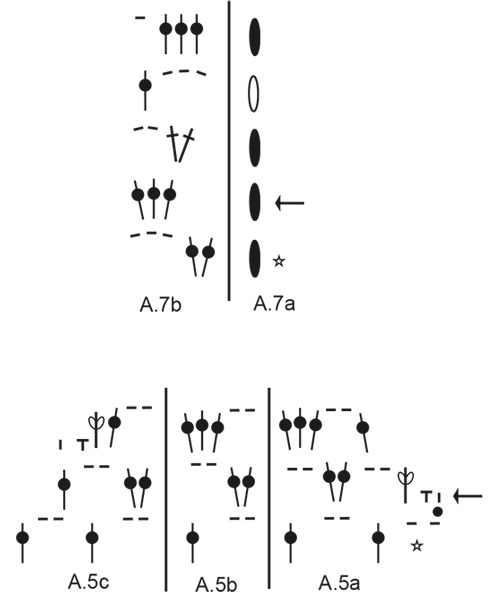
|
||||||||||||||||||||||||||||||||||||||||
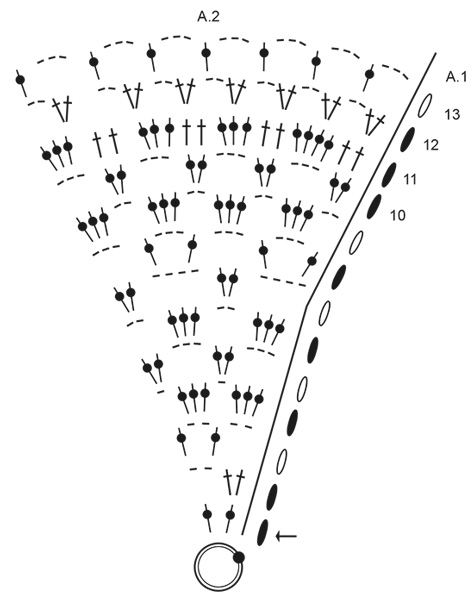
|
||||||||||||||||||||||||||||||||||||||||

|
||||||||||||||||||||||||||||||||||||||||

|
||||||||||||||||||||||||||||||||||||||||
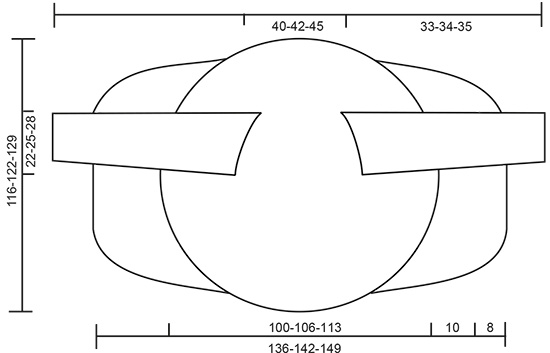
|
||||||||||||||||||||||||||||||||||||||||
|
Have you made this or any other of our designs? Tag your pictures in social media with #dropsdesign so we can see them! Do you need help with this pattern?You'll find tutorial videos, a Comments/Questions area and more by visiting the pattern on garnstudio.com. © 1982-2024 DROPS Design A/S. We reserve all rights. This document, including all its sub-sections, has copyrights. Read more about what you can do with our patterns at the bottom of each pattern on our site. |
||||||||||||||||||||||||||||||||||||||||







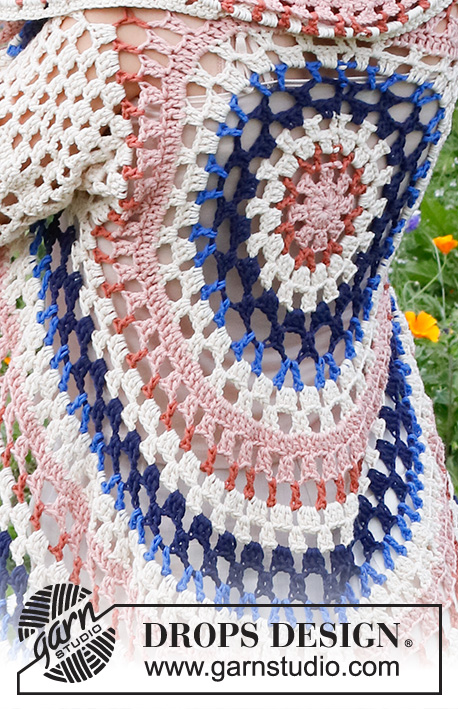
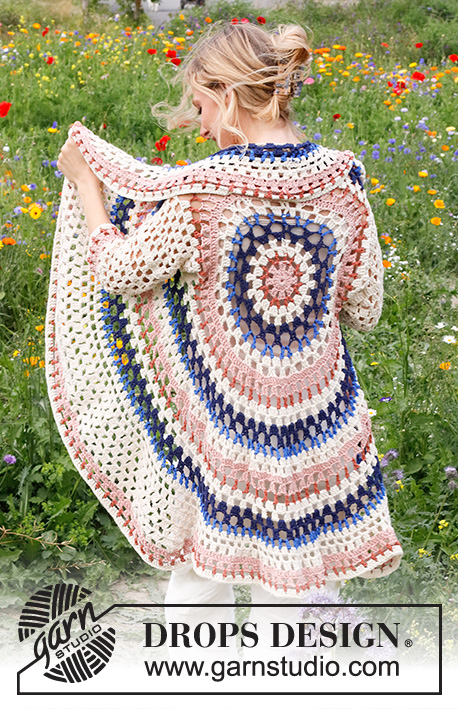

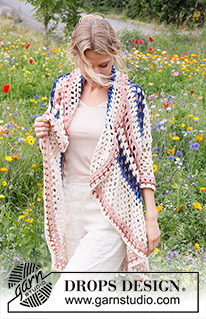
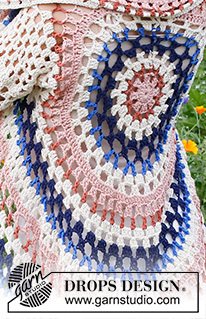


















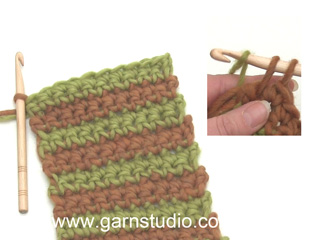





























Comments / Questions (27)
Country flag Gigi wrote: Ik begrijp de boord afwerking niet ! Boord een en terug is gedaan… maar dan Hoe moet ik de boord afwerken ? En waar beginnen als je 6 toeren heen een terug hebt ????
18.04.2024 - 09:11Country flag Gigi wrote: Ik begrijp de boord afwerking niet ! Boord een en terug is gedaan… maar dan Hoe moet ik de boord afwerken ? En waar beginnen als je 6 toeren heen een terug hebt ????
17.04.2024 - 13:09Hej, när jag har gjort min ring med fem luftmaskor så kan jag inte hitta hur många maskor det ska vara runt ringen. Komplicerat mönster, Mvh Marianne Kristoffersen
14.04.2024 - 17:53DROPS Design answered:
Hei Marianne. Du starter med å hekle 5 luftmasker og setter de en en ring. For å finne ut hvilken farger du skal hekle med, les STRIPER. Når du har satt de 5 luftmaskene i en ring hekler du etter diagram A.1 (A.1 viser hvordan omgangen starter og slutter), deretter hekles A.2 totalt 8 ganger rundt på omgangen / rundt ringen. Altså, hekle 3 luftmasker(=1 stav), deretter hekles det 2x8 staver (=16 staver om ringen). Avslutt omgangen med 1 kjedemaske i 3. luftmaske på begynnelsen av omgangen. mvh DROPS Design
15.04.2024 - 14:33Varför finns det en förklaring med luftmaskan?? --- VAD ÄR DET FÖR UPPDATERING med garnet marinblå och blå? DET ÄR JU LIKADANT som i beskrivningen!!! Uppdaterad online: 08.03.2023 Rättelse GARNÅTGÅNG: ... 100-100-100 g färg 28, marinblå 50-50-50 g färg 09, kungsblå
12.04.2024 - 18:34DROPS Design answered:
Hei Marianne. Det fins en forklaring på 1 luftmaske slik at man hekler den riktig. Det er fort gjort å hekle for stramt, lar "løkken" bli like stram som hakket rett under kroken istedenfor tykkelsen på selve heklenålen (den lange delen). Da oppskriften ble publisert var det en annen garnmengde, og dersom noen har skrevet ut oppskriften med feil garnmengde kan de se at garnmengden er blitt forandret 08.03.2023. Etter denne datoen vil riktig garnmengde stå i selve oppskriften og under rettelse linken. mvh DROPS Design
15.04.2024 - 13:14Het aantal steken klopt niet
13.07.2023 - 14:56Mijn cirkel is af, maar ik heb veel meer steken. 240 Hoe moet ik dan beginnen met de zijkanten? Welke steken verhouding? Ik heb deze vraag een paar weken geleden ook al gesteld!
13.07.2023 - 14:55DROPS Design answered:
Dag Ineke,
Komt jouw stekenverhouding in de breedte verder wel overeen met die van het patroon? Dan zou je het te veel aan steken evenredig kunnen verdelen over de steken tussen de armsgaten, dus aan de bovenkant bij de hals en aan de onderkant van de cirkel. Het aantal te haken lossen en steken die over slaat voor de armsgaten blijft wel gelijk.
13.07.2023 - 19:40Piirroksen a6 tähdellä merkityn pylväskerroksen jälkeen pylväitä on s-koossa 44, mutta seuraavan kerroksen lopetus ei sovi tähän pylväsmäärään, vaan se on sovitettu 46 pylvääseen. Tämä vaikuttaa koko loppuhihan pylväsmääriin, ja hihasta tulee leveämpi kuin ohjeessa. Onko ohjeessa virhe ja miten hiha kuuluu virkata 44:n pylvään kerroksen jälkeen?
06.03.2023 - 15:28DROPS Design answered:
Hei, tarkistamme ohjeen ja teemme siihen tarvittaessa korjauksen.
16.03.2023 - 19:13Als je naar het originele patroon kijkt moet toer 4 en 5 naturel zijn en niet woestijnroos. Tip;,Mocht je breed geschouderd zijn raad ik je aan om de grootste maat te haken. Die valt bij mij normaal (misschienntikkienstrak terwijl ik maat L/XL heb shirt/vest maat. Erg leuk patroon met veel afwisseling. Mijn eerste patroon die ik volg en probeer en het is met een beetje puzzelen goed te doen. Ik ben nu bij toer 21, dus nog wel een stuk te gaan :)
21.01.2023 - 00:45Goedendag, \r\n\r\nIn het patroon onder het kopje strepen staat toer 4-5 woestijnroos, maar als je naar de foto kijkt dan is toer 4-5 naturel.\r\nDit klopt ook met het aantal bollen garen denk ik, want naturel heb ik het meeste van gekocht!!!!
29.10.2022 - 23:51Guten Tag, wie viele Stäbchen gehören in den Ring? Finde nirgends eine Angabe. Häkelschrift kann ich lesen, aber werde auch leider aus dieser nicht schlau. Lg
19.09.2022 - 10:26DROPS Design answered:
Liebe Jeannine, A.2 wird 8 Mal in der Runde gehäkelt, bei der 1. Runde in A.2 häkeln Sie 2 Stäbchen x 8 Rapporte = 16 Stb nach der 1. Runde. Viel Spaß beim häkeln!
19.09.2022 - 11:28